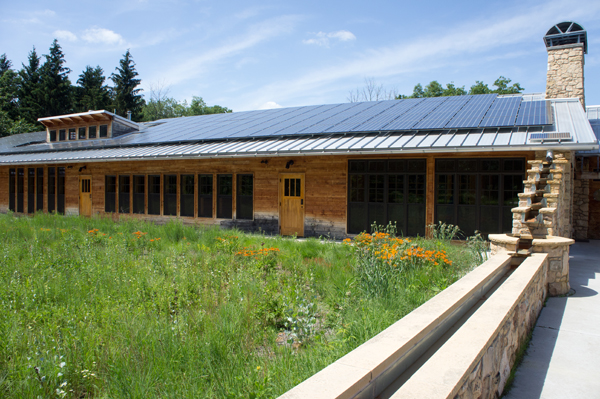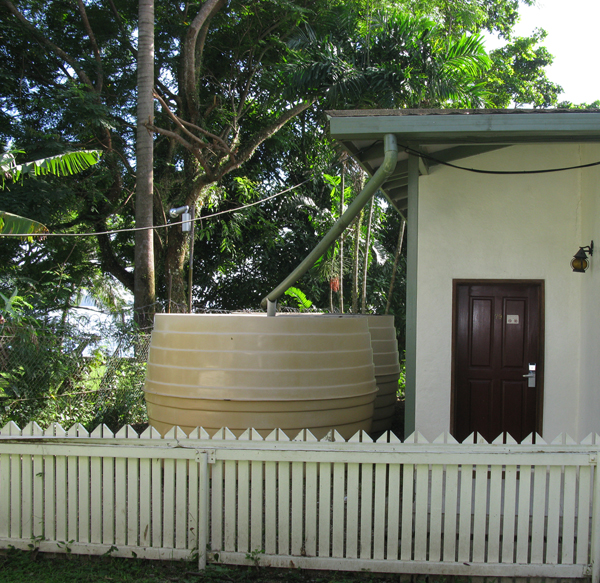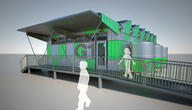You are here
Rainwater harvesting means capturing and storing rain that falls on-site (usually on roofs). It is generally used for irrigation and toilet flushing or other greywater uses, though it can also be used for drinking water if it is adequately treated.
![]()
Capturing rainwater can be a valuable way to reduce or even eliminate a building's use of municipal potable water, without requiring reductions in water use by occupants. However, it is of course more effective in rainy climates than dry ones.
Rainwater harvesting systems are measured by their area for collecting water (in m2 or ft2) and the volume of water they store (in liters or gallons).
Simple rainwater collection systems have three main elements: the roof or other catchment area, the storage tank(s), and the gutter and other piping that directs the water from the catchment area to the tank.
 |
| photo: Jeremy Faludi |
The Aldo Leopold Center turns a rainwater-harvesting gutter into an aesthetic water feature
Advanced systems may also use a pump to pull water from the tank to where it is used, and may purify the water with additional devices such as filters and ultraviolet disinfection.
If the rainwater is meant for drinking or watering gardens, be sure to choose a tank material that does not leach toxins or foster pathogens. For example, galvanized steel tanks are lined with polyethylene or other food-grade liner.
If the rainwater is collected from a roof is meant for drinking or watering gardens, be sure to choose roofing materials that do not leach toxins. For instance, asphalt shingles leach toxins into water, while metal roofs or slate shingles do not.
Predicting Rainwater Harvest Rate
To size a system for a site, you must choose the water collecting area to supply enough volume of water for the site occupants, given the site's rainfall patterns. The simplest equation for system sizing is this:
(Volume) = (Area) • (Precipitation) • (% Efficiency)
Volume is the amount of rain harvested in that time period, measured in liters. Area is the rainwater capture area, measured in m2. Precipitation is the amount of rainfall in that time period (in mm). Efficiency is the percent of water actually captured, as opposed to splashing out of the system somewhere; it is usually 75% - 90%.1
In English units, a coefficient must be added:
(Volume) = (Area) • (Precipitation) • (0.62 gal/ft2/inch) • (% Efficiency)
Here volume is in gallons, area is in ft2, precipitation is in inches.
Occupant Needs
The volume of water needed by the occupants will vary based on the number of occupants, the amount of time they spend on site, the activities they engage in, and the equipment or processes used on site. See Water-Efficient Fixtures and Equipment and Water-Efficient Irrigation and Landscaping for calculations to determine water usage needs.
These needs are often constant throughout the year, but if they vary by season, be sure to incorporate that in your calculations.
Rainfall
Weather data from TMY files can be used to determine rainfall patterns. These will be in mm or inches of rain.
Be sure to calculate average monthly rainfall for the different months of the year, not simply an annual total. Most sites have much more rainfall in some seasons than others, and excess water can always be drained, but a lack of water requires municipal water use to compensate.
Efficiency
Different gutter systems, different roof pitches, and different materials can affect system efficiency. For example, lower-pitch roofs cause less loss than steeply-pitched roofs.
Sizing Rainwater Tanks
There is no one standard recommended size for rainwater storage tanks. The size depends on the site's water needs, the weather, and whether the site is connected to a municipal water supply or not. While bigger tanks allow for more water independence, the tank is usually the most expensive part of the system.
Systems that do not have municipal water backup (called "off-grid") must hold much more water, in case of shortage. The amount of oversizing depends on how crucial the water needs are--discretionary water use like lawns or water features can be done without for days or weeks at a time, while drinking water cannot.
 |
| photo: Jeremy Faludi |
Off-grid residential rainwater catchment tanks
The main consideration for sizing a storage tank is the worst-case length of time between rains. This can be seen by graphing the TMY precipitation data by day, rather than simply finding monthly precipitation averages. After you have calculated the occupants' water needs and the average frequency and magnitude of rain in the dry season, you should multiply the resulting tank size by a "safety factor" to provide room for error or extreme weather.

